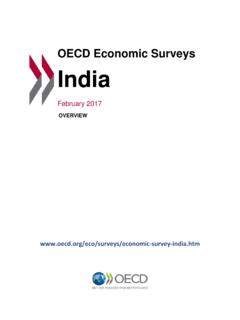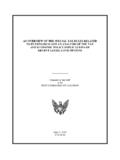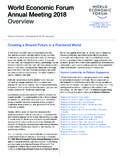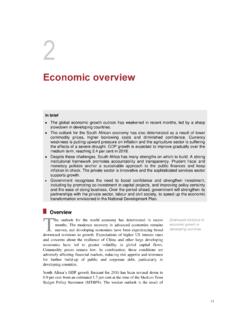Transcription of Economic overview - National Treasury
1 112 Economic overview In brief The South African economy, which grew by an estimated per cent in 2016, is expected to grow by per cent in 2017 and 2 per cent in 2018 as Economic conditions strengthen. The global Economic growth outlook has improved, but is clouded by policy uncertainty as the world trading system comes under mounting pressure. Government continues to work with business and labour to rebuild confidence, promote investment and improve prospects for more inclusive growth. South Africa needs broad-based Economic transformation that creates jobs and business opportunities for black South Africans, reduces inequality and boosts income growth for all citizens.
2 overview outh Africa s GDP growth rate is forecast to increase in 2017 and improve moderately over the medium term. Economic growth of per cent is projected for 2017, reaching per cent by 2019. Factors supporting the forecast include marginally higher global growth, stabilising commodity prices, greater reliability of the electricity network, more favourable weather conditions, recovering business and consumer confidence, and improved labour relations. The positive trajectory marks a break with several years of declining growth. Yet the projected rate of growth is not high enough to markedly reduce unemployment, poverty and inequality.
3 Inclusive growth requires broad-based transformation to break down structural impediments to new Economic activities, enable millions of black South Africans to generate income and accumulate capital, and raise per capita incomes across the board. In the short term, South Africa needs to bolster business and consumer confidence to support higher levels of investment. By improving policy certainty, safeguarding investment-grade credit ratings, and ensuring that the state meets its regulatory and service-delivery obligations, government can boost growth. Medium- and long-term reforms are outlined in the S Projected Economic growth of per cent in 2017 Government can boost growth by ensuring that it meets its regulatory and service-delivery obligations 2017 BUDGET REVIEW 12 National Development Plan (NDP).
4 Broad-based transformation requires improved education and skills development, deconcentration of monopolised industries, private-sector participation in sectors dominated by public enterprises to promote competition and reduce costs, city reform to expand urban infrastructure development, and regional integration. Government will continue to work with business and labour to rebuild confidence and improve prospects for more inclusive growth. The work of the Presidential Business Working Group and the CEO Initiative have led to improvements in the business registration process and the regulatory environment, and increased funding for small businesses and internships.
5 Pressure on world trading system The 2008 financial crisis and its aftermath exposed growing fault lines in the world economy. The slow recovery, accompanied by the uneven distribution of benefits from global trade, has increased social and political pressures for change. Today these strains manifest in various ways, including the rise of strident Economic nationalism and protectionist policies. The policy direction of the new US administration, the UK s vote to leave the European Union, and elections in Germany and France during 2017 are contributing to global uncertainty. South Africa s prudent macroeconomic and fiscal policies, which include inflation targeting and a flexible exchange rate, enable the economy to adjust to global volatility, and provide a stable platform for investment.
6 Pressure on the global trading system, however, is expected to mount. The resulting uncertainty is the biggest risk to global recovery and domestic growth prospects. Expanding global trade within a multilateral system is in South Africa s interests and those of the entire African continent. But opportunities for such trade may narrow over the medium term. Global outlook Global growth declined marginally to per cent in 2016, from per cent in 2015, due to policy uncertainty, sluggish investment growth and slowing global trade. The International Monetary Fund (IMF) projects that the world economy will grow by per cent in 2017 and per cent in 2018.
7 This forecast is clouded by the absence of a clear policy trajectory in developed economies and risks to Chinese growth. Growth in advanced economies is projected to remain around 2 per cent over the medium term. Growth in the US, the world s largest economy, is forecast to reach per cent in 2017 and per cent in 2018. This is premised on the introduction and success of a fiscal stimulus. Stronger growth in the second half of 2016 has led to upward revisions of forecasts for Germany, Japan, Spain and the UK. Developing economies are expected to remain the main contributors to higher global growth in 2017 and 2018.
8 Brazil and Russia should return to moderate growth following recessions in both countries. Growth in India is projected to remain above 7 per cent, and Chinese growth is forecast to decelerate but remain above 6 per cent. A major risk to Chinese growth remains the rapid expansion of credit and high levels of corporate debt. Government is working with business and labour to rebuild confidence Pressure on global trading system set to increase Improved global outlook clouded by lack of policy clarity in developed economies and risks to Chinese growth CHAPTER 2: Economic overview 13 The outlook for sub-Saharan Africa, a major export destination for South African manufacturers, has been revised marginally up to per cent for 2018, based largely on a slight increase in commodity prices.
9 Global inflation is expected to increase moderately over the short term, driven by stabilising commodity prices and rising productive capacity utilisation in China. Monetary policy in advanced economies is expected to remain largely supportive of growth in the short term, but the pace of monetary policy tightening in the US could increase capital flow volatility. Assumptions used in the Economic forecast The main assumptions used in the National Treasury s Economic forecast are published below. The forecast incorporates the outlook for 15 major trading partners as presented in the IMF s January 2017 World Economic Outlook Update.
10 Average growth of per cent is projected for these economies in 2017. Commodity prices are expected to remain stable over the medium term. The outlook reflects decelerating growth in China. Table Annual percentage change in GDP and inflation in selected regions/countriesRegion/countryPercentag e 2015 2016 2017 2018 2015 2016 2017 Advanced United Euro United Emerging markets and developing Brazil


















